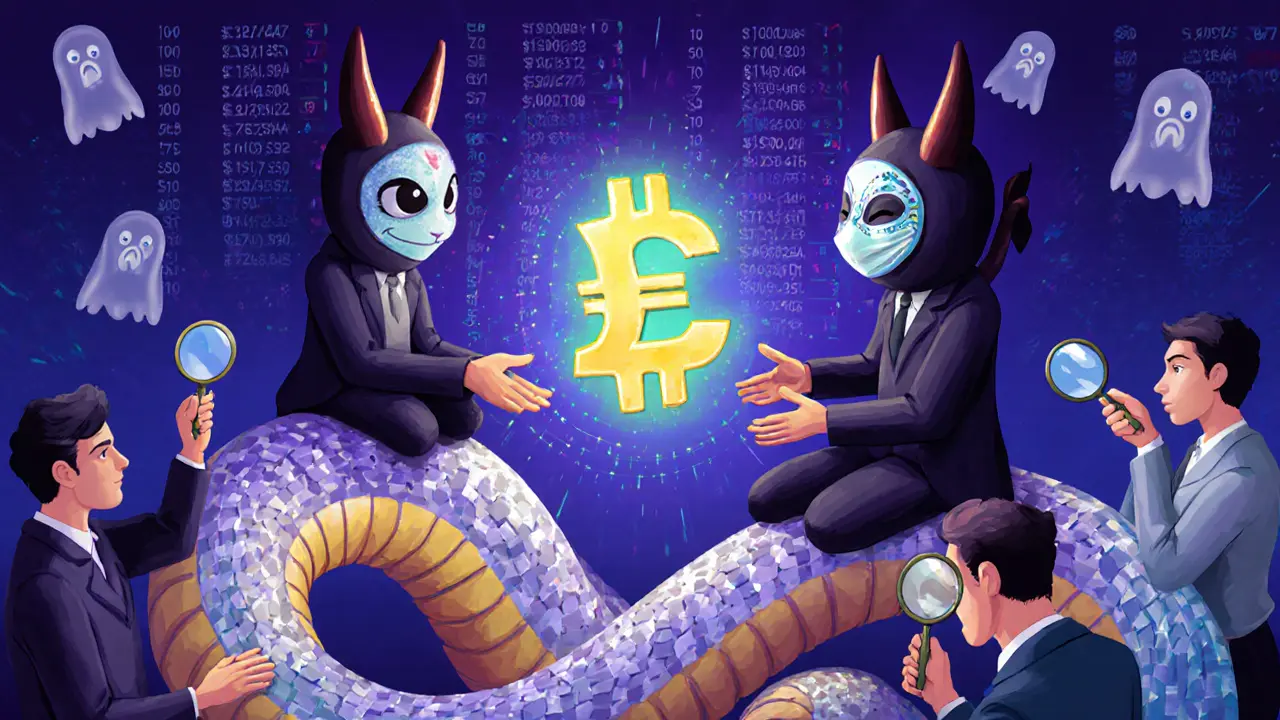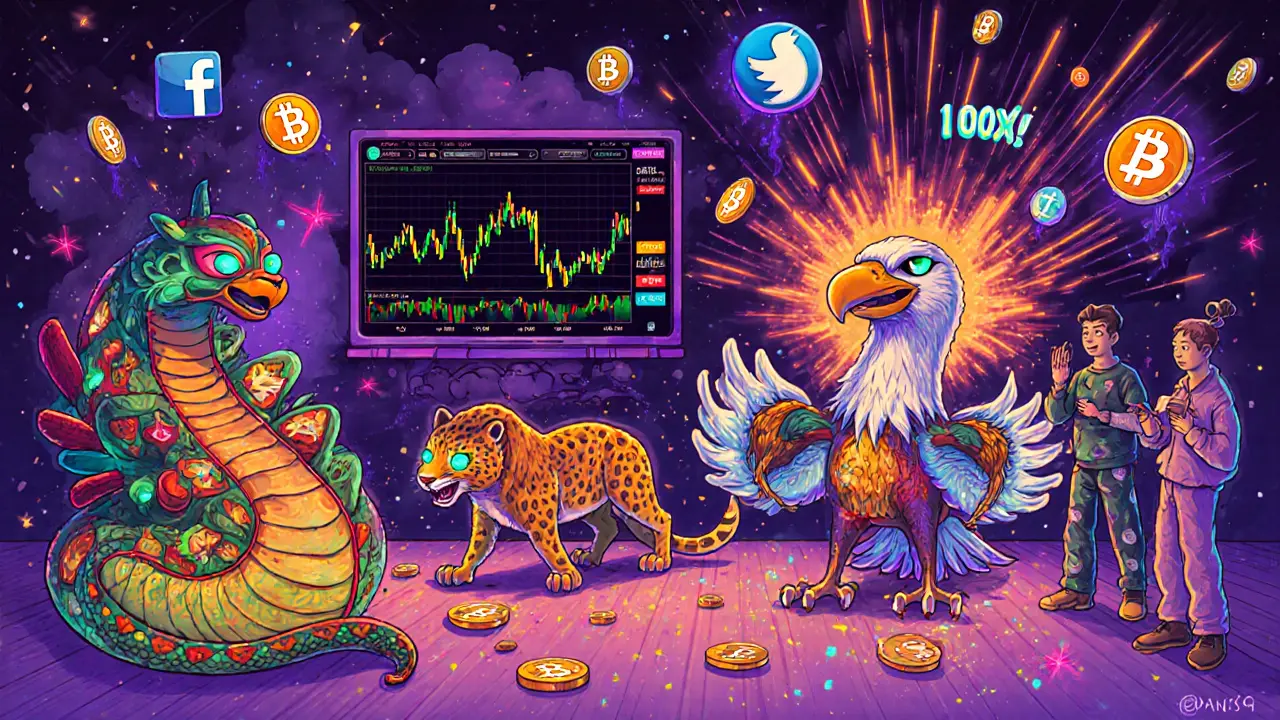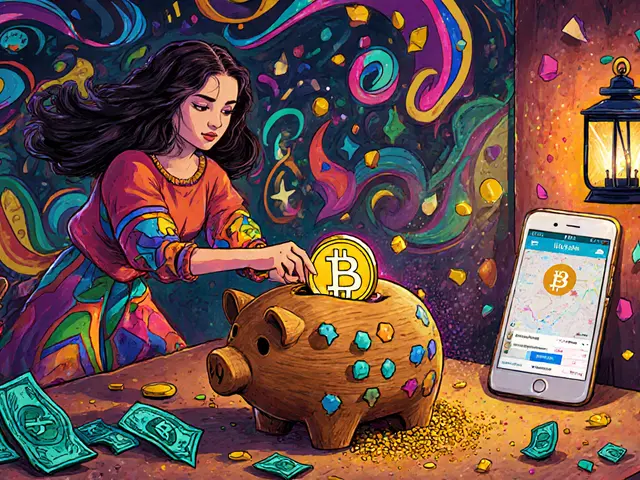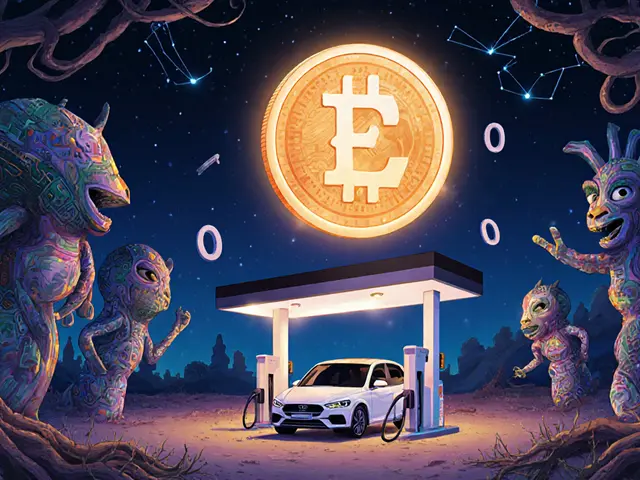Market Cap Manipulation Detector
Enter Token Metrics
Results
Imagine buying a cryptocurrency because everyone on Twitter is screaming about it. The price shoots up 200% in a day. You feel like you’ve hit the jackpot. Then, two hours later, it crashes 80%. You’re left holding a digital asset worth pennies. This isn’t bad luck. It’s market cap manipulation - and it’s happening right now, every single day, across hundreds of crypto projects.
Market cap isn’t a measure of real value. It’s just price multiplied by circulating supply. That means if you can trick people into buying a token, you can inflate its market cap - even if the project has zero utility, no team, and no code. And once the market cap looks impressive, more investors jump in, thinking it’s legitimate. That’s the trap.
Pump and Dump: The Most Common Scam
Pump and dump is the bread and butter of crypto manipulation. It’s simple: a group of people - often influencers or organized groups - buy a low-cap token. They flood social media, Telegram, and Discord with fake hype: "This is the next Bitcoin!" "100x coming soon!" "Only 100 people know about this!"
Retail investors, scared of missing out, rush to buy. The price spikes. Then, the insiders sell everything. The price collapses. The people who bought last lose everything. In 2023, over 90,000 tokens were flagged as part of pump-and-dump schemes, generating more than $240 million in illegal profits.
It’s not just random trolls. In October 2024, the FBI ran a sting called "Operation Token Mirrors." They created a fake crypto project called NexFundAI. Within weeks, 18 people were arrested for running a $25 million pump-and-dump on it. The scam was so organized, they had scripts, bots, and social media calendars. This isn’t a fringe issue. It’s an industry.
Wash Trading: Fake Volume, Fake Trust
When you see a crypto trading $50 million a day, you assume there’s real demand. But more than 70% of trading volume on small exchanges is fake. That’s wash trading.
Here’s how it works: a trader owns two wallets. They send tokens from one to the other. Buy. Sell. Buy. Sell. Over and over. The blockchain shows high volume. The exchange sees it and lists the token. New traders see the volume and think, "This must be popular." They buy in. But there’s no real buyers - just the same person moving money between their own accounts.
Exchanges benefit too. High volume makes them look more liquid. More traders use them. More fees. Some exchanges even pay traders to wash trade. It’s a win-win for the manipulators - and a disaster for unsuspecting investors.
How to spot it? Look at the order book. If there’s no depth - no buy orders below the current price - and volume is high, that’s a red flag. Check the transaction history on a blockchain explorer. If you see the same addresses sending tokens back and forth, it’s wash trading.
Spoofing and Sell Walls: The Silent Manipulation
Spoofing is like playing poker with a fake hand. You place a huge sell order - say, 10,000 tokens at $0.50 - to make it look like there’s massive resistance. Traders see it and think, "The price won’t go above $0.50." They hold off. The manipulator quietly buys tokens at $0.40, $0.35, $0.30.
Then, they cancel the fake sell wall. The price rockets to $0.80. The manipulator sells everything. The people who waited for the "resistance" are left buying at the top.
Sell walls are especially common on low-liquidity altcoins. They’re cheap to set up and devastatingly effective. You don’t need to own a lot of the token - just enough to move the price when no one else is trading.
Look for huge sell orders hanging on the order book with no matching buys. If it disappears suddenly and the price spikes, that’s a classic spoofing move.

Oracle Manipulation: Hacking the Truth
DeFi protocols rely on oracles - third-party services that feed real-world prices into smart contracts. If you can trick the oracle, you can trick the whole system.
In October 2022, a trader named Avraham Eisenberg manipulated the price oracle on Mango Markets, a Solana-based DeFi platform. He bought Mango tokens, then used them as collateral to borrow more tokens. He drove the price up by buying more, then sold everything. He made $115 million in one day.
The SEC charged him with market manipulation. Mango Markets sued to recover $47 million. This wasn’t a hack. It was legal arbitrage - until regulators stepped in. The lesson? If a DeFi project uses a single, centralized oracle, it’s vulnerable. Always check: Is the price feed decentralized? Who controls it?
Multi-Exchange Manipulation: The Invisible Hand
There are over 100 crypto exchanges. Each one has its own order book. That’s a problem for regulators - and a gift for manipulators.
Here’s how cross-market manipulation works: A group buys a token on Exchange A. They push the price up. They report the price rise to Exchange B, which uses Exchange A’s price as a reference. Exchange B’s traders see the spike and buy in. The manipulators then sell on Exchange B at the higher price. They repeat across 5 or 6 exchanges.
The result? A token appears to be surging across the entire market. But it’s not organic. It’s choreographed. And because no single exchange sees the full picture, detection is nearly impossible.

How to Protect Yourself
You can’t stop manipulation. But you can avoid becoming the victim.
- Avoid low-liquidity tokens. If a token trades less than $1 million a day, it’s a target. High liquidity = harder to manipulate.
- Check the volume vs. price movement. If price jumps 50% but volume stays flat, it’s suspicious. Real demand increases volume.
- Ignore social media hype. If a token is trending on Twitter or TikTok, it’s probably being pumped. Wait 48 hours. If the price drops 30%, you know why.
- Use blockchain explorers. Look at the top 10 holders. If one wallet owns 30% of the supply, that’s a red flag. They can dump anytime.
- Don’t chase pumps. If something goes up 100% in 2 hours, it’s not a trend. It’s a trap.
Most importantly: Never invest based on FOMO. If you don’t understand why a token has value - beyond the hype - don’t buy it.
The Bigger Picture
Market cap manipulation isn’t just about losing money. It erodes trust. Institutional investors won’t enter crypto markets if they believe prices are rigged. Regulators are catching on - the SEC is now treating crypto like securities. More arrests. More lawsuits. More scrutiny.
But as long as there are unregulated exchanges, anonymous wallets, and retail investors chasing quick gains, manipulation will continue. The only defense? Education. Awareness. And discipline.
Crypto is still wild west. But you don’t have to be the cowboy getting shot. Learn the tricks. Spot the signs. And walk away from anything that smells too good to be true - because it almost always is.











10 Comments
Man, I’ve been burned so many times by these pump-and-dump schemes. I remember buying some random token called ‘DogeMoonAI’ because some guy on Twitter had a whole PowerPoint presentation on it. Two hours later, my portfolio looked like a funeral. The worst part? The project’s GitHub was empty, the team had zero LinkedIn profiles, and the whitepaper was just a copy-paste of Bitcoin’s with ‘AI’ slapped on every other sentence. I swear, if I see ‘100x’ one more time, I’m deleting all my crypto apps.
THIS. IS. EVERYTHING. 🚨💥 I’ve been watching this for years and it’s insane how easy it is to fool people. I used to be one of those guys buying every ‘next Bitcoin’ tweet. Now I just laugh and check the order book. If there’s a 10k sell wall at $0.50 and zero buys below $0.45? That’s a trap. Don’t be the sucker. 💪📈
It’s wild how much of this is just theater. Like, imagine you’re a kid in 1920s Chicago watching a guy sell ‘miracle cure’ bottles on the street. Same energy. Only now, instead of a horse-drawn cart, it’s a Telegram group with 50k members and a bot that auto-posts ‘BUY NOW’ every 3 minutes. And the worst part? People still fall for it. I’ve seen grandmas in Ohio buying tokens because a TikTok influencer said ‘this’ll make you rich before your next coffee break.’
It’s not even about the money anymore. It’s about the psychology. The FOMO, the dopamine hit of seeing your balance go up, the ego of thinking you’re ‘in the know.’ That’s what keeps the machine running. And until people realize they’re not investing - they’re participating in a performance - nothing’s gonna change.
Y’all need to start checking token holders on Etherscan or Solana Explorer before you buy anything. Seriously. I once saw a token where the top 3 wallets owned 78% of the supply. One of them was labeled ‘Unknown Wallet’ with 32% - that’s not a community, that’s a bomb waiting to go off. And if the volume is 10x higher than the market cap? Red flag. Big red flag. 🚩 I’m not trying to scare you, but I’ve lost too many friends to this. Take 10 minutes. Look. Then decide.
Wow. Another amateur crypto guide for people who can’t even read a whitepaper. You think wash trading is new? It’s been around since the 1800s on the NYSE. And you call this ‘manipulation’? It’s called market dynamics. If you’re too stupid to spot fake volume or a spoofed order book, you deserve to lose. Stop blaming the market. Fix your brain. Also, ‘Oracle manipulation’? That’s called arbitrage. The real scam is people thinking DeFi is safe. Go back to stocks, kid.
meh. i read this. i get it. but like... why do people still do this? 🤷♀️
Just wanted to add - if you’re serious about avoiding scams, use tools like Nansen or Arkham. They track wallet behavior. If you see a wallet that buys a token, holds for 2 hours, then dumps 90% of it across 12 different exchanges? That’s a classic insider dump. Also, check the token’s contract code on Etherscan. If it’s got a ‘mint’ function or a ‘blacklist’ feature? That’s a red flag. Don’t just trust the chart. Look under the hood.
And please - if you’re new to crypto, start with Bitcoin or Ethereum. Not some random token with ‘DeFi’ in the name and a Discord group full of bots. I’ve seen too many people lose their life savings because they thought ‘next 100x’ meant ‘guaranteed return.’ It doesn’t. It means ‘you’re the last guy holding the bag.’
Stay safe. Do your homework. And don’t let hype override logic.
omg i just realized i bought a token last week that had a 10k sell wall and zero buy orders… like… why did i not check?? 😅 i’m so embarrassed. but honestly, i just got caught up in the hype. everyone was saying ‘this is it!’ and i didn’t wanna miss out. now i’m just holding it like a weird pet. i’ve got a little sign on my desk that says ‘fomo kills’ and i stare at it every time i think about buying something new. it helps. kinda.
THIS IS A CRIME AGAINST HUMANITY. 😤 I’ve watched people lose their rent money on these scams - single moms, college kids, retirees. And the people running these schemes? They’re laughing all the way to the bank, buying Lambos and private jets while the rest of us are left with digital trash. The SEC needs to shut down these exchanges. PERIOD. No more ‘it’s decentralized so we can’t regulate it’ nonsense. If you’re facilitating fraud, you’re complicit. And if you’re still telling people to ‘just HODL’ after a 90% dump? You’re part of the problem. Wake up. Stop romanticizing chaos. This isn’t crypto. It’s a casino with a blockchain logo.
Wow. A 10-page essay on how people are dumb. How original. 🙃 I’m sure the FBI sting operation was just a coincidence. And the fact that 90% of tokens are scams? That’s just… market efficiency? Right? I mean, if you can’t spot a pump-and-dump while scrolling TikTok with your coffee… maybe crypto isn’t for you. But hey - at least the memes are funny.